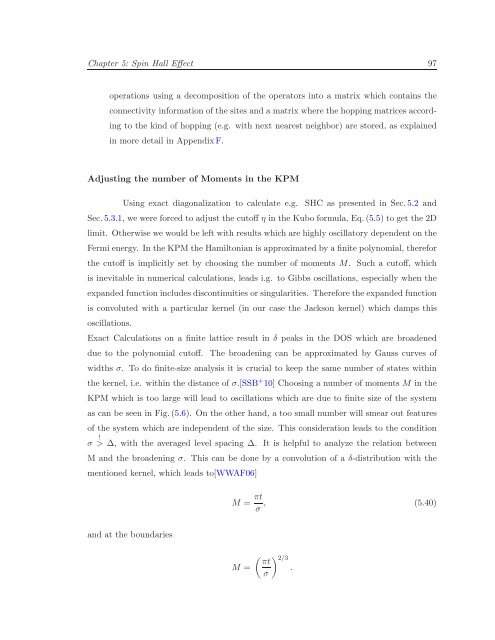Itinerant Spin Dynamics in Structures of ... - Jacobs University
Itinerant Spin Dynamics in Structures of ... - Jacobs University
Itinerant Spin Dynamics in Structures of ... - Jacobs University
You also want an ePaper? Increase the reach of your titles
YUMPU automatically turns print PDFs into web optimized ePapers that Google loves.
Chapter 5: <strong>Sp<strong>in</strong></strong> Hall Effect 97<br />
operations us<strong>in</strong>g a decomposition <strong>of</strong> the operators <strong>in</strong>to a matrix which conta<strong>in</strong>s the<br />
connectivity <strong>in</strong>formation <strong>of</strong> the sites and a matrix where the hopp<strong>in</strong>g matrices accord<strong>in</strong>g<br />
to the k<strong>in</strong>d <strong>of</strong> hopp<strong>in</strong>g (e.g. with next nearest neighbor) are stored, as expla<strong>in</strong>ed<br />
<strong>in</strong> more detail <strong>in</strong> AppendixF.<br />
Adjust<strong>in</strong>g the number <strong>of</strong> Moments <strong>in</strong> the KPM<br />
Us<strong>in</strong>g exact diagonalization to calculate e.g. SHC as presented <strong>in</strong> Sec.5.2 and<br />
Sec.5.3.1, we were forced to adjust the cut<strong>of</strong>f η <strong>in</strong> the Kubo formula, Eq.(5.5) to get the 2D<br />
limit. Otherwise we would be left with results which are highly oscillatory dependent on the<br />
Fermi energy. In theKPM the Hamiltonian is approximated by a f<strong>in</strong>itepolynomial, therefor<br />
the cut<strong>of</strong>f is implicitly set by choos<strong>in</strong>g the number <strong>of</strong> moments M. Such a cut<strong>of</strong>f, which<br />
is <strong>in</strong>evitable <strong>in</strong> numerical calculations, leads i.g. to Gibbs oscillations, especially when the<br />
expandedfunction <strong>in</strong>cludesdiscont<strong>in</strong>uities ors<strong>in</strong>gularities. Thereforetheexpandedfunction<br />
is convoluted with a particular kernel (<strong>in</strong> our case the Jackson kernel) which damps this<br />
oscillations.<br />
Exact Calculations on a f<strong>in</strong>ite lattice result <strong>in</strong> δ peaks <strong>in</strong> the DOS which are broadened<br />
due to the polynomial cut<strong>of</strong>f. The broaden<strong>in</strong>g can be approximated by Gauss curves <strong>of</strong><br />
widths σ. To do f<strong>in</strong>ite-size analysis it is crucial to keep the same number <strong>of</strong> states with<strong>in</strong><br />
the kernel, i.e. with<strong>in</strong> the distance <strong>of</strong> σ.[SSB + 10] Choos<strong>in</strong>g a number <strong>of</strong> moments M <strong>in</strong> the<br />
KPM which is too large will lead to oscillations which are due to f<strong>in</strong>ite size <strong>of</strong> the system<br />
as can be seen <strong>in</strong> Fig.(5.6). On the other hand, a too small number will smear out features<br />
<strong>of</strong> the system which are <strong>in</strong>dependent <strong>of</strong> the size. This consideration leads to the condition<br />
σ ! > ∆, with the averaged level spac<strong>in</strong>g ∆. It is helpful to analyze the relation between<br />
M and the broaden<strong>in</strong>g σ. This can be done by a convolution <strong>of</strong> a δ-distribution with the<br />
mentioned kernel, which leads to[WWAF06]<br />
M = πt<br />
σ , (5.40)<br />
and at the boundaries<br />
M =<br />
( ) πt 2/3<br />
.<br />
σ
















